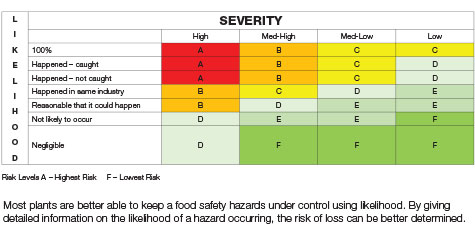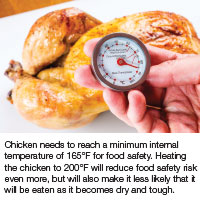For example, when you arrive at a busy intersection, you have to decide to proceed or wait: What level of severity is the hazard? Is the vehicle that is coming toward you a semi, sports car, work van, or bicycle? Next, you assess the likelihood of the hazard occurring: What is the speed zone? Is it foggy or icy? Are you running late? Are you distracted by your cell phone or kids?
Keep in mind that the risk is the potential loss, and it is based on the functional outcome of the severity of the hazard magnified by the likelihood that it might occur. In other words, the inputs to the equation are the worst-case outcome of the hazard if it occurs along with the likelihood of the occurrence.
The outcome is the total risk you are taking by the decision made. Notice that you are more in control of likelihood than you are of severity. For example, you can’t control the size of the vehicle coming toward you, but you can control being distracted by your cell phone. Also, you instinctively make different driving decisions when roads are icy because the likelihood of a collision is greater than if conditions are good.
When you arrive at work, were you asked if you had a documented risk assessment for the trip before you left? Did you document the risk at the time it happened? Of course, the answer is no; however, in the food industry it should be yes.
The current legal position is that if it was not documented, it didn’t happen, as no objective evidence can be provided. This can be very frustrating, as circumstantial evidence (no accident) says there was no issue. This evidence, however, does not tell the observer how close to failure you came (e.g., the driver of the oncoming car had to slam on the brakes to avoid a collision).
Hazard analyses that evaluate the severity and likelihood of each hazard to provide evidence that the risk is controlled are required in food facilities. Processes need to be monitored to ensure critical elements are in place and do not fail.
Severity
Normally categorized into three or four levels, severity of food hazards will range from “It will kill you” to “Minimal discomfort that might or might not be noticed.” However, there is very little that a food facility can do about the severity of a hazard. While not a food safety risk (and not a HACCP requirement), quality hazards also can be identified and controlled via the analysis of hazards for total risk. Additionally, many food items have food safety risks and quality risks working against each other.
For example, chicken needs to reach a minimum internal temperature of 165°F for food safety. Heating the chicken to 200°F will reduce food safety risk even more, but will also make it less likely that it will be eaten as it becomes dry and tough. Allergens are another severe food safety hazard. While most people have no reaction to allergens, they are deadly to some. If a cookie contains peanut butter that is not declared on the label, it would result in an allergic reaction if someone with a peanut allergy consumes it. Thus, pathogens and allergens would be listed as the highest level of severity in a hazard analysis.
Another consideration is available resources. What resources do you use to learn about and understand all the potential hazards that can cause food hazards? If you are not at least using FDA guidance, customer input, and published studies, you are leaving yourself vulnerable. Other common resources are supplier certificates and in-plant expertise. Are the resources you use to determine food safety hazards published documents? Are they current? Do they consider regulatory requirements? Are hazards specifically identified (e.g., they don’t just say pathogens if the concern is specific to Salmonella)?

Likelihood
Most plants are better able to keep food safety hazards under control using likelihood. Likelihood controls can include monitoring of the entire food process via storage temperature, cooking time/temperature, pH, metal detectors, labeling checks, truck inspection, inventory control, pest control, chemical control, sanitation, line changeovers, preventive maintenance, and employee handwashing.
Program monitoring verifies that the hazard is kept under control. When completing a hazard analysis, the food safety team is responsible for evaluating the likelihood of a hazard occurring. For example, the likelihood of peanut protein (allergen) in peanut butter is 100%. The likelihood of Salmonella in raw chicken is not 100%, but it is high enough to assume it is going to affect your products over time.
If a plant uses four severity levels on a risk assessment, it should consider using five to seven levels for likelihood. The number of levels should be defined by the ability to give descriptive differences between them.
For example:
Level 1 – 100% likely to occur (e.g., the above allergen example).
Level 2 – It has happened in the past at this plant and was caught by existing controls.
Level 3 – It has happened in the past at this plant and was not caught.
Level 4 – It has happened in similar food manufacturing plants.
Level 5 – It could reasonably occur.
Level 6 – The chance of it occurring is not likely.
Level 7 – The chance of it happening is negligible.
By giving this type of detailed information on the likelihood of a hazard occurring, the risk of loss can be better determined. For example, during a recent audit, the form being used to verify labels on finished products was listed as Version 0 and had been created within the last eight months. When asked if it was a new check and why they were doing it, the company responded that they had started doing the check after a customer complained earlier that year of a shipped product arriving with the wrong label.
Further investigation determined that this change in their procedure was not included in the HACCP plan hazard analysis, even though the potential to ship undeclared allergens (if the label mistake was an allergen-containing product labeled with a non-allergen label) had been brought to their attention.
They claimed it was a quality complaint, not a HACCP failure because the product shipped did not have any allergens in it that were not included in the ingredient deck. In this case, they failed to control the likelihood of mislabeled product by not having adequate checks. They also failed to update their food safety hazard analysis by not documenting the failure or that a new control point was implemented.

Risk
Once the hazard severity and the likelihood have been properly identified, a food safety team can evaluate the risk associated with any failure. The risk matrix is evaluated based on the individual facility’s management responsibility.
For example, risk levels (in the table on page 7) could mean the facility would:
a. Be criminally liable for food safety neglect;
b. Be sued and put out of business;
c. Be responsible for recall and/or medical claims;
d. Have to answer a customer complaint and provide new product or a refund;
e. Not receive a customer complain but customer would probably not do repeat business;
f. Not have the issue noticed by a customer.
Risk assessment can be used to identify risks and show they are being controlled by monitoring control points. A good risk assessment template has three to four levels of severity and five to seven levels of likelihood, since likelihood is where hazards are controlled. The risk is a multiplied calculation of the overall severity and the overall likelihood, and is best shown as a matrix that compares the likelihood and severity to come up with the total risk.
Once documented and approved by the food safety management team, this matrix can then be used to evaluate the need for control; high risks are controlled by CCP monitoring, medium risks are controlled by control point monitoring, and low risks are controlled by good manufacturing practices.
What is the risk of failure?
The risk of failure is a concept often overlooked in a food safety or quality plan. Most people have firsthand experience or know someone who has experienced a routine airplane repair that takes more than an hour to complete (e.g., replacing a lightbulb on the airplane wing). Because the risk of failure is catastrophic, this carries over into the way an airline maintains its equipment and document repairs.
A similar risk of failure holds true for food safety. Eating leftovers that were not properly refrigerated often occurs, even with knowledgeable food scientists. Internally, the risk is assumed because it will only make the individual consuming the potentially affected product sick. However, preparing and packing potentially compromised food in a food facility has the opportunity to make hundreds or thousands of people sick. To add to this risk, the chance of immunocompromised people consuming the tainted product increases if it is distributed to the general public. The potential risk becomes catastrophic since it has the chance of severely affecting (up to and including death) many people. Facility management is responsible for ensuring that their employees know how they can impact the safe handling and distribution of food and are aware of how improper processing or handling may cause sickness or death to consumers.
Although much of food manufacturing is relatively low risk and the risk of failure is not as likely to be catastrophic, some foods that were considered low risk a few years ago are now viewed at a much higher risk level due to documented food poisoning events that have led to recall. Examples include certain spices, peanut butter, and produce.
Country of origin also has added to the risk potential, most notably the melamine contamination of wheat gluten. Risk levels also increase as they get closer to the end consumer. For example, cookie dough that will be further processed into baked cookies has a lower risk potential than cookie dough being consumed raw or going into ice cream.
Hazard Assessment
What does a hazard assessment look like? A traditional HACCP hazard analysis matrix compares the likelihood and severity against each other as a multiplier effect; the equation of the two is the potential risk.
While this method can be applied to any type of required hazard analysis, good risk assessments have been documented into facilities’ quality management system as objective statements or program requirements.
Additionally risk assessments are made on the frequency of an internal audit schedule stating HACCP, complaints, and pest control would be audited quarterly; sanitation, maintenance and training would be audited twice per year; and all other QMS programs would be audited annually—with this frequency based on the significance of each program (i.e., severity) and the identified failures of each program noted in past audits (i.e., likelihood). The frequency was reviewed and approved annually by the food safety team.
GFSI quality systems are expected to be risk-based. This means that all potential hazards associated with a facility’s raw materials, ingredients, packaging, finished products, and employees have to be identified and shown to be under control. This should include hazards against food safety and product legality in both the country of manufacturer and the countries of distribution. These hazard analyses are considered to be site-specific and should be developed with site personnel input.
Additionally, the GFSI scheme (i.e. SQF, BRC, FSSC 22000, IFS) requires risk assessments against specific scheme requirements. When required, the facility is responsible for documenting the risk assessment (either as a matrix or a well-written objective statement), or a non-conformance will be noted in their audit report.
Summary
How well is your risk assessment documented? Does it cover all hazards that might be associated with your products? Does it rate risks based on likelihood and severity? Are your risks properly identified (likelihood x severity) and adequately controlled to an acceptable level? Do your HACCP team members know their level of responsibility, and have they been trained to perform documented risk assessments? Do you identify where and when your food safety controls fail so improvements can be identified and implemented? Do you use the same concept of risk management to identify and control quality risks?
Since risk is identified as a financial loss, and quality issues cost companies excessive revenue each day, this same risk design works well to identify losses and establish adequate controls to prevent reoccurrences. More and more, these are all becoming the industry norm for managing food safety and quality risks.
About the Authors
Mark Weighner and Tess Burlingame
The authors are IFS Manager, AIB International, and Quality Manager, FSS Specialty and Certification Programs, AIB International, respectively.




